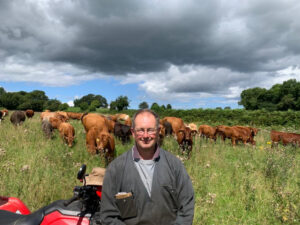 The judges will be looking for a grower delivering consistently strong yields which can only be achieved with an effective beetle control policy and a commitment to investing in soil health. The winning Oilseed Grower will be able to demonstrate a track record of innovating to manage challenges faced, seeking expert assistance where appropriate. Sponsored by Premium Crops
The judges will be looking for a grower delivering consistently strong yields which can only be achieved with an effective beetle control policy and a commitment to investing in soil health. The winning Oilseed Grower will be able to demonstrate a track record of innovating to manage challenges faced, seeking expert assistance where appropriate. Sponsored by Premium Crops
Richard Budd – Stevens Farm (Hawkhurst)
The vulnerability of winter oilseed rape to cabbage stem flea beetle (CSFB) has seen many growers abandon the crop. But not Richard. He wants winter oilseed rape in the mix, because a wide rotation is the foundation for good crop yields.
With a five-year average of 5.45t/ha, Richard has been a serial Yield Enhancement Network winner. Recognition is always pleasing, but the reason for participation is as a testbed for ideas. Richard likes to base decisions on experience.
He is also a member of various groups and clubs such as the BASF Real Results group, and hosts the AICC South East rapeseed trials. What can be tested has, and it has delivered results.
The most successful of those trials was exploring the effectiveness of delayed planting (mid-September). “It became apparent that this adopted strategy was a powerful tool in avoiding crops becoming infested with CSFB. We have never lost a crop or had to spray for flea beetles since we avoid the main flight period,” he says.
 It also revealed additional benefits. Crops have less biomass coming out of winter, but lower disease pressure too. However, being healthier improves spring vigour, allowing the crop to optimise its yield.
It also revealed additional benefits. Crops have less biomass coming out of winter, but lower disease pressure too. However, being healthier improves spring vigour, allowing the crop to optimise its yield.Richard also runs his own variety trials, a shortlist of around five to establish which suits their late-planting strategy. They are also evaluated for their robustness to disease before he advances them to becoming mainstream varieties.
Further work has looked at improving crop evenness, one of the reasons for investing in a direct disc drill. He has now managed to succeed in getting the whole crop to emerge in a 24-48-hour window, something he considers invaluable to reduce slugs grazing off slowly emerging cotyledons.
The other is reducing the lodging risk from higher seed rates. By working with BASF on different Caryx rates, Richard now has a canopy management strategy that delivers highly branched crops but reduces lodging risk.
There has also been a focus on soil health and precision farming. The result is a 15% reduction in bagged nitrogen requirements. “We are as confident as we have ever been that oilseed rape is a cornerstone of our rotation, not only because of what it adds in terms of resilience, but also what it brings to the business in returns,” he concludes.
Guy Prudom – P Prudom and Son Limited
Guy Prudom reintroduced winter OSR to widen his rotation, with grassweed control being a factor. He has now completed six harvests. The weather has hindered performance over the past two seasons and
dented his rotational plans. For the four years beforehand, the farm averaged 4.8t/ha.
dented his rotational plans. For the four years beforehand, the farm averaged 4.8t/ha.
He is doing everything at his disposal to make the most of oilseed rape’s rotational benefits while also making it pay.
 Over the past six seasons, companion crops have always been included. Following little success with berseem clover, he moved to buckwheat. Last season he trialled fenugreek with buckwheat in the neighbouring field as a comparison.
Over the past six seasons, companion crops have always been included. Following little success with berseem clover, he moved to buckwheat. Last season he trialled fenugreek with buckwheat in the neighbouring field as a comparison.That typifies his approach of continual testing and evaluating, always looking to refine where possible. He suggests the best thing he has done is move to precision soil testing. This has led to a much more targeted approach to phosphate and potash applications.
An application of farmyard manure prior to OSR establishment also helps. The beef unit produces about 700t of farmyard manure each year. When applied at 15t/ha it is not enough to cover the whole farm each year, so the next best thing is to grow cover crops over winter in front of the spring crops.
A Mzuri strip-till drill has been a boon, not only for rapid crop establishment, but also to minimise moisture loss.
This is all is helping Guy to improve soil health, which he believes has a much bigger effect on the viability of OSR than anything else. “This has been proven time and time again as we rotate the crop around the farm. Where we have had a history of farmyard manure application and long tenure of the land, we have achieved better OSR yields.”
Reduced cultivation and the use of cover crops have seen soil organic matter rise from 35% to 45% over the past four years.
Biostimulants, both foliar-applied and seed treatments, are extensively used to optimise plant health. This has the potential to allow similar yields to be achieved with a lower level of both nitrogen fertiliser and fungicide inputs, especially when combined with varietal disease resistance.
Acacia has been the variety of choice over the past few years. It offers good disease ratings, good autumn growth and early spring vigour. The last time an insecticide was used was in 2022. Trials with biostimulant Vita Protect rendered them redundant.



